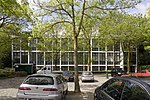Jekerkwartier
Neighbourhoods of Maastricht

The Jekerkwartier (Dutch pronunciation: [ˈjeːkərkʋɑrˌtiːr]; Limburgish: Jekerkerteer [ˈjeːkəʀkəʀˌteːʀ]) is a neighbourhood in the old city centre of Maastricht, Limburg, Netherlands. It is named after the Jeker river that flows through the neighbourhood into the Meuse.
Excerpt from the Wikipedia article Jekerkwartier (License: CC BY-SA 3.0, Authors, Images).Jekerkwartier
Henri Hermanspark, Maastricht
Geographical coordinates (GPS) Address Nearby Places Show on map
Geographical coordinates (GPS)
| Latitude | Longitude |
|---|---|
| N 50.844166666667 ° | E 5.6913888888889 ° |
Address
Rode Brug
Henri Hermanspark
6211 JP Maastricht
Limburg, Netherlands
Open on Google Maps









